
The expanding fireball and shockwave of the Trinity explosion, seen .025 seconds after detonation on July 16, 1945.
Until the atomic bomb could be tested, doubt would remain about its effectiveness. The world had never seen a nuclear explosion before, and estimates varied widely on how much energy would be released. Some scientists at Los Alamos continued privately to have doubts that it would work at all.
There was only enough weapons-grade uranium available for one bomb, and confidence in the gun-type design was high, so on July 14, 1945, most of the uranium bomb (“Little Boy”) began its trip westward to the Pacific without its design having ever been fully tested.
A test of the plutonium bomb seemed vital, however, both to confirm its novel implosion design and to gather data on nuclear explosions in general.
Several plutonium bombs were now “in the pipeline” and would be available over the next few weeks and months. It was therefore decided to test one of these.
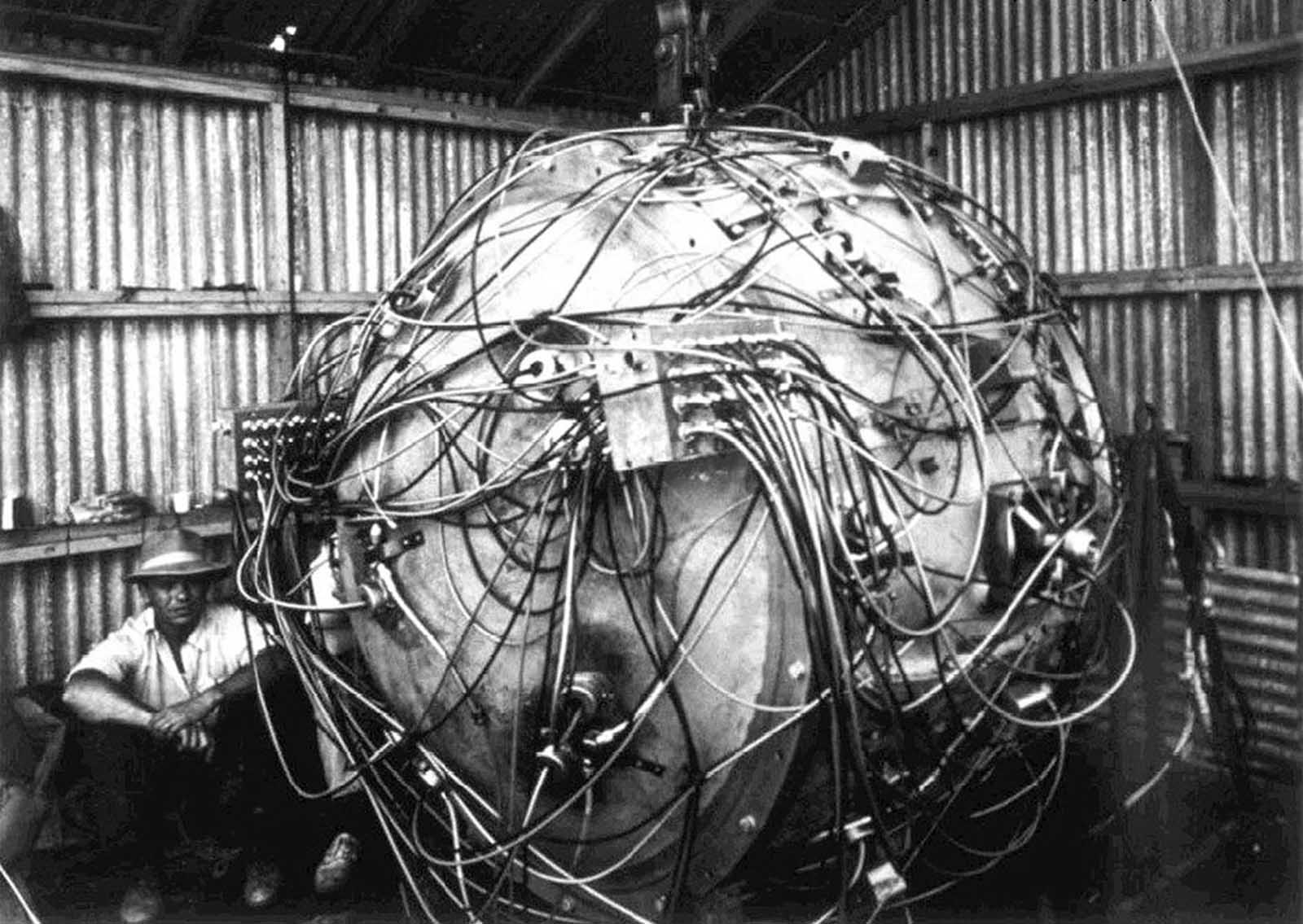
Exposed wiring of “The Gadget,” the nuclear device that exploded as part of Trinity, the first test of an atomic bomb. At the time of this photo, the device was being prepared for its detonation, which took place on July 16, 1945.
Robert Oppenheimer chose to name this the “Trinity” test, a name inspired by the poems of John Donne. The site chosen was a remote corner on the Alamagordo Bombing Range known as the “Jornada del Muerto”, or “Journey of Death”, 210 miles south of Los Alamos.
The elaborate instrumentation surrounding the site was tested with an explosion of a large amount of conventional explosives on May 7. Preparations continued throughout May and June and were complete by the beginning of July.
Three observation bunkers located 5.6 miles north, west, and south of the firing tower at ground zero would attempt to measure key aspects of the reaction. Specifically, scientists would try to determine the symmetry of the implosion and the amount of energy released.
Additional measurements would be taken to determine damage estimates, and equipment would record the behavior of the fireball. The biggest concern was control of the radioactivity the test device would release.
Not entirely content to trust favorable meteorological conditions to carry the radioactivity into the upper atmosphere, the Army stood ready to evacuate the people in surrounding areas.
On July 12, the plutonium core was taken to the test area in an army sedan. The non-nuclear components left for the test site at 12:01 a.m., Friday the 13th.
During the day on the 13th, the final assembly of the “Gadget” (as it was nicknamed) took place in the McDonald ranch house. By 5:00 p.m. on the 15th, the device had been assembled and hoisted atop the 100-foot firing tower.
Leslie Groves, Vannevar Bush, James Conant, Ernest Lawrence, Thomas Farrell, James Chadwick, and others arrived in the test area, where it was pouring rain.
Groves and Oppenheimer, standing at the S-10,000 control bunker, discussed what to do if the weather did not break in time for the scheduled 4:00 a.m. test.
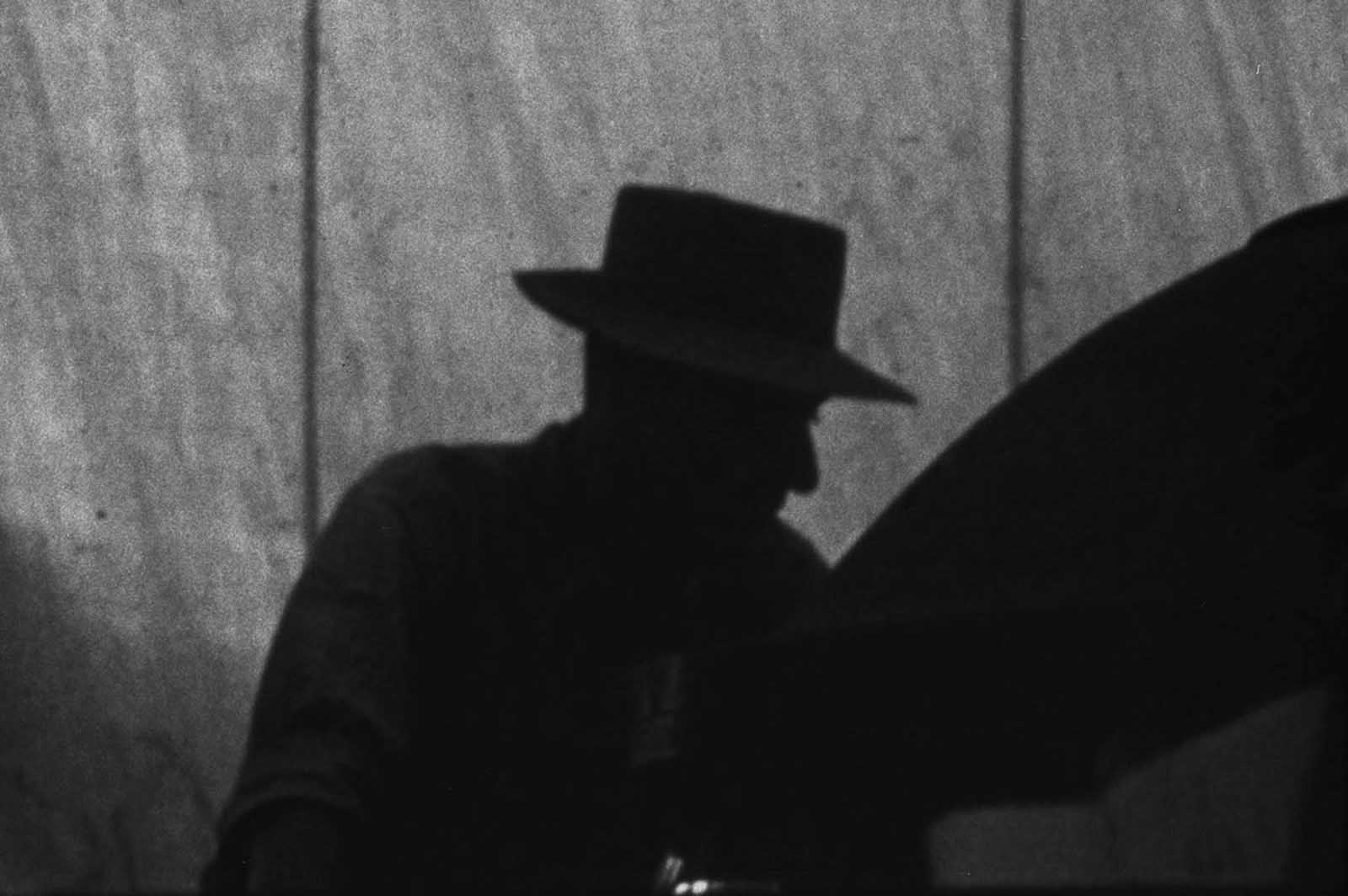
Los Alamos director J. Robert Oppenheimer is seen in silhouette as he oversees the final assembly of the Gadget at the Trinity test site in July of 1945.
To break the tension, Fermi began offering anyone listening to a wager on “whether or not the bomb would ignite the atmosphere, and if so, whether it would merely destroy New Mexico or destroy the world”. Oppenheimer himself had bet ten dollars against George Kistiakowsky’s entire month’s pay that the bomb would not work at all.
Meanwhile, Edward Teller was making everyone nervous by applying liberal amounts of sunscreen in the pre-dawn darkness and offering to pass it around.
At 3:30, Groves and Oppenheimer pushed the time back to 5:30. At 4:00, the rain stopped. Kistiakowsky and his team armed the device shortly after 5:00 and retreated to S-10,000. In accordance with his policy that each observes from different locations in case of an accident, Groves left Oppenheimer and joined Bush and Conant at base camp.
Those in shelters heard the countdown over the public address system, while observers at base camp picked it up on an FM radio signal.
During the final seconds, most observers laid down on the ground with their feet facing the Trinity site and simply waited. As the countdown approached one minute, Isidore Rabi said to the man lying next to him, Kenneth Griesen, “Aren’t you nervous?” “Nope” was Griesen’s reply.
As Groves later wrote, “As I lay there in the final seconds, I thought only of what I would do if the countdown got to zero and nothing happened”.
Conant said he never knew seconds could be so long. As the countdown reached 10 seconds, Griesen suddenly blurted out to his neighbor Rabi, “Now I’m scared”. Three, two, one, and Sam Allison cried out, “Now!”
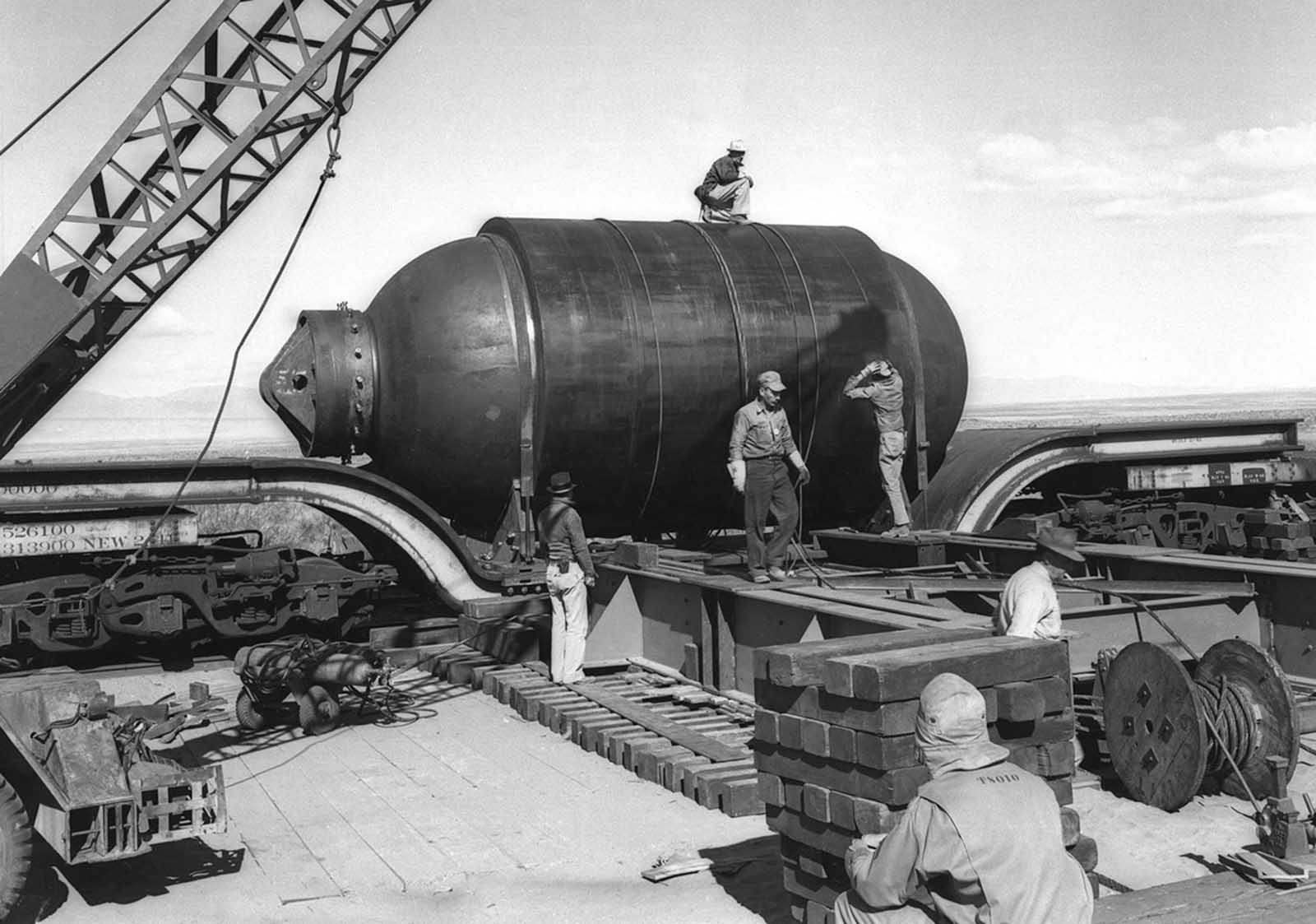
Jumbo, a 200-ton steel canister designed to recover the plutonium used in the Trinity test in the event that the explosives used were unable to trigger a chain reaction. In the end, Jumbo wasn’t used for recovery but was placed near ground zero to help gauge the effects of the blast. It survived intact, but its support tower did not.
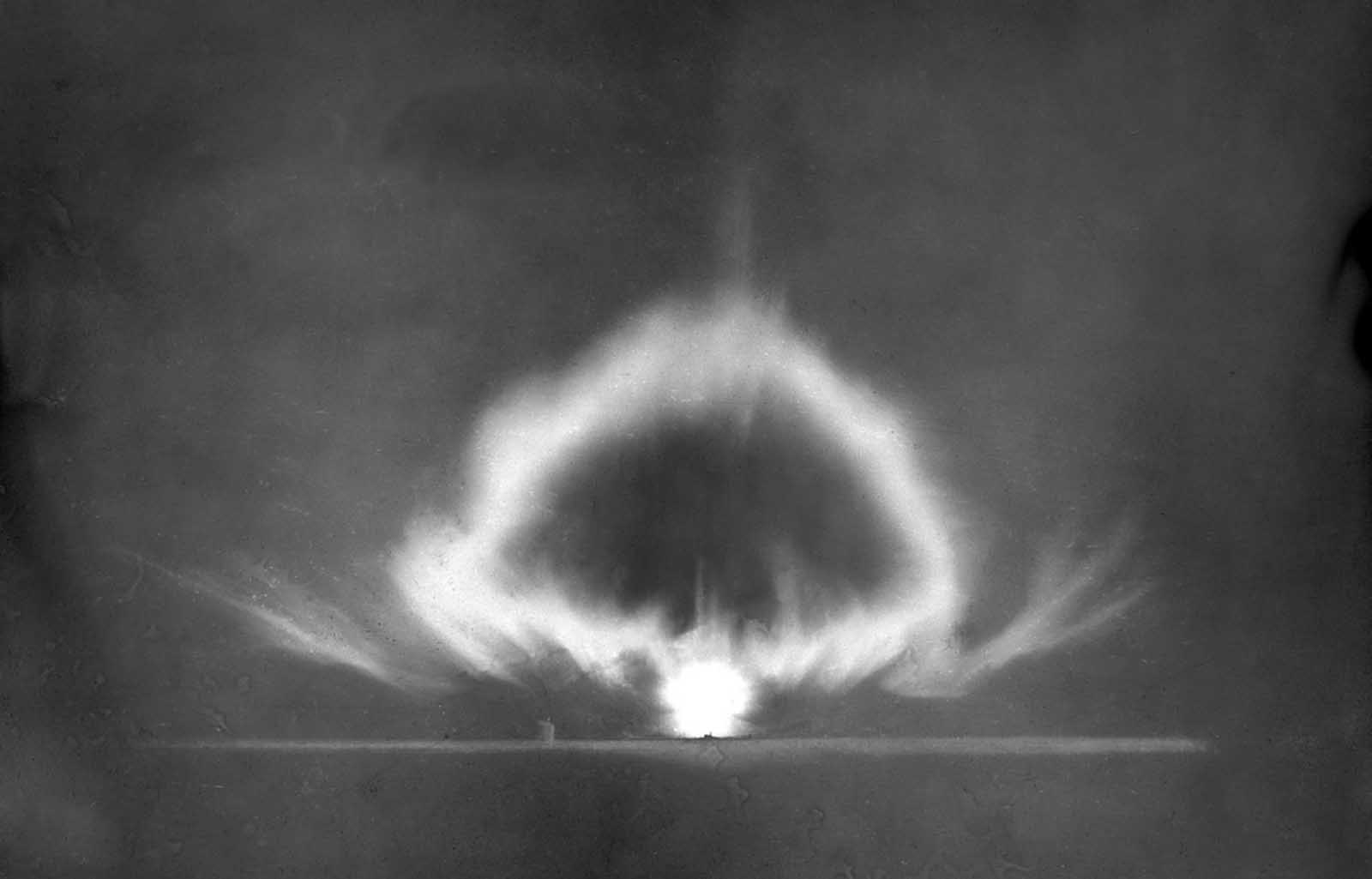
A longer-exposure photograph of the Trinity explosion seconds after detonation on July 16, 1945.
At precisely 5:30 a.m. on Monday, July 16, 1945, the nuclear age began. While Manhattan Project staff members watched anxiously, the device exploded over the New Mexico desert, vaporizing the tower and turning the asphalt around the base of the tower to green sand. Seconds after the explosion, came a huge blast wave and heat searing out across the desert.
No one could see the radiation generated by the explosion, but they all knew it was there. The steel container “Jumbo”, weighing over 200 tons and transported to the desert only to be eliminated from the test, was knocked ajar even though it stood half a mile from ground zero.
As the orange and yellow fireball stretched up and spread, a second column, narrower than the first, rose and flattened into a mushroom shape, thus providing the atomic age with a visual image that has become imprinted on the human consciousness as a symbol of power and awesome destruction.
The most common immediate reactions to the explosion were a surprise, joy, and relief. Lawrence was stepping from his car when, in his words, everything went “from darkness to brilliant sunshine in an instant”; he was “momentarily stunned by the surprise”.
A military man was heard to exclaim, “The long-hairs have let it get away from them!” Hans Bethe, who had been looking directly at the explosion, was completely blinded for almost half a minute. Norris Bradbury reported that “the atom bomb did not fit into any preconceptions possessed by anybody”.

The expanding fireball and shockwave of the Trinity explosion, seen .053 seconds after detonation on July 16, 1945.
The blast wave knocked Kistiakowsky (who was over five miles away) to the ground. He quickly scrambled to his feet and slapped Oppenheimer on the back, saying, “Oppie, you owe me ten dollars”. The physicist Victor Weisskopf reported that “our first feeling was one of elation”.
The word Isidor Rabi used was “jubilant”. Within minutes, Rabi was passing around a bottle of whiskey. At base camp, Bush, Conant, and Groves shook hands.
When they met, Groves said to Oppenheimer, “I am proud of you”. Groves’s assistant, Thomas Farrell, remarked to his boss that “the war is over”, to which Groves replied, “Yes, after we drop two bombs on Japan”.
Probably the most mundane response of all was Fermi’s: he had calculated ahead of time how far the blast wave might displace small pieces of the paper released into it.
About 40 seconds after the explosion, Fermi stood, sprinkled his pre-prepared slips of paper into the atomic wind, and estimated from their deflection that the test had released energy equivalent to 10,000 tons of TNT.
The actual result as it was finally calculated — 21,000 tons (21 kilotons) — was more than twice what Fermi had estimated with this experiment and four times as much as had been predicted by most at Los Alamos.

A fireball begins to rise, and the world’s first atomic mushroom cloud begins to form, nine seconds after Trinity detonated on July 16, 1945.
Soon shock and euphoria gave way to more sober reflections. Rabi reported that after the initial euphoria, a chill soon set in on those present.
The test director, Kenneth Bainbridge, called the explosion a “foul and awesome display” and remarked to Oppenheimer, “Now we are all sons of bitches”. Expressions of horror and remorse are especially common in the later writings of those who were present.
Oppenheimer wrote that the experience called to his mind the legend of Prometheus, punished by Zeus for giving man fire, and said also that he thought fleetingly of Alfred Nobel’s vain hope that dynamite would end wars.
Most famously, Oppenheimer later recalled that the explosion had reminded him of a line from the Hindu holy text, the Bhagavad-Gita: “Now I have become Death, the destroyer of worlds”.
The terrifying destructive power of atomic weapons and the uses to which they might be put were to haunt many of the Manhattan Project scientists for the remainder of their lives.
The success of the Trinity test meant that both types of bombs – the uranium design, untested but thought to be reliable, and the plutonium design, which had just been tested successfully – were now available for use in the war against Japan.
Little Boy, the uranium bomb, was dropped first at Hiroshima on August 6, while the plutonium weapon, Fat Man, followed three days later at Nagasaki on August 9. Within days, Japan offered to surrender.

U.S. military observers watch the explosion during Operation Crossroads Baker, a nuclear test conducted on Bikini Atoll on July 25, 1946. This was the fifth nuclear explosion ever, after two other tests and the two bombs dropped on Hiroshima and Nagasaki.

A massive column of water rises from the sea as the U.S. detonates an atomic bomb at Bikini Atoll in the Pacific in the first underwater test of the device, on July 25, 1946. The blast and the enormous wave of water that followed immediately overwhelmed several abandoned ships, which were part of the site’s dummy fleet of former warships.

A huge mushroom cloud rises above Bikini Atoll in the Marshall Islands on July 25, 1946, following an atomic test blast, part of the U.S. military’s Operation Crossroads. The dark spots in the foreground are ships that were placed near the blast site to test what an atomic bomb would do to a fleet of warships.
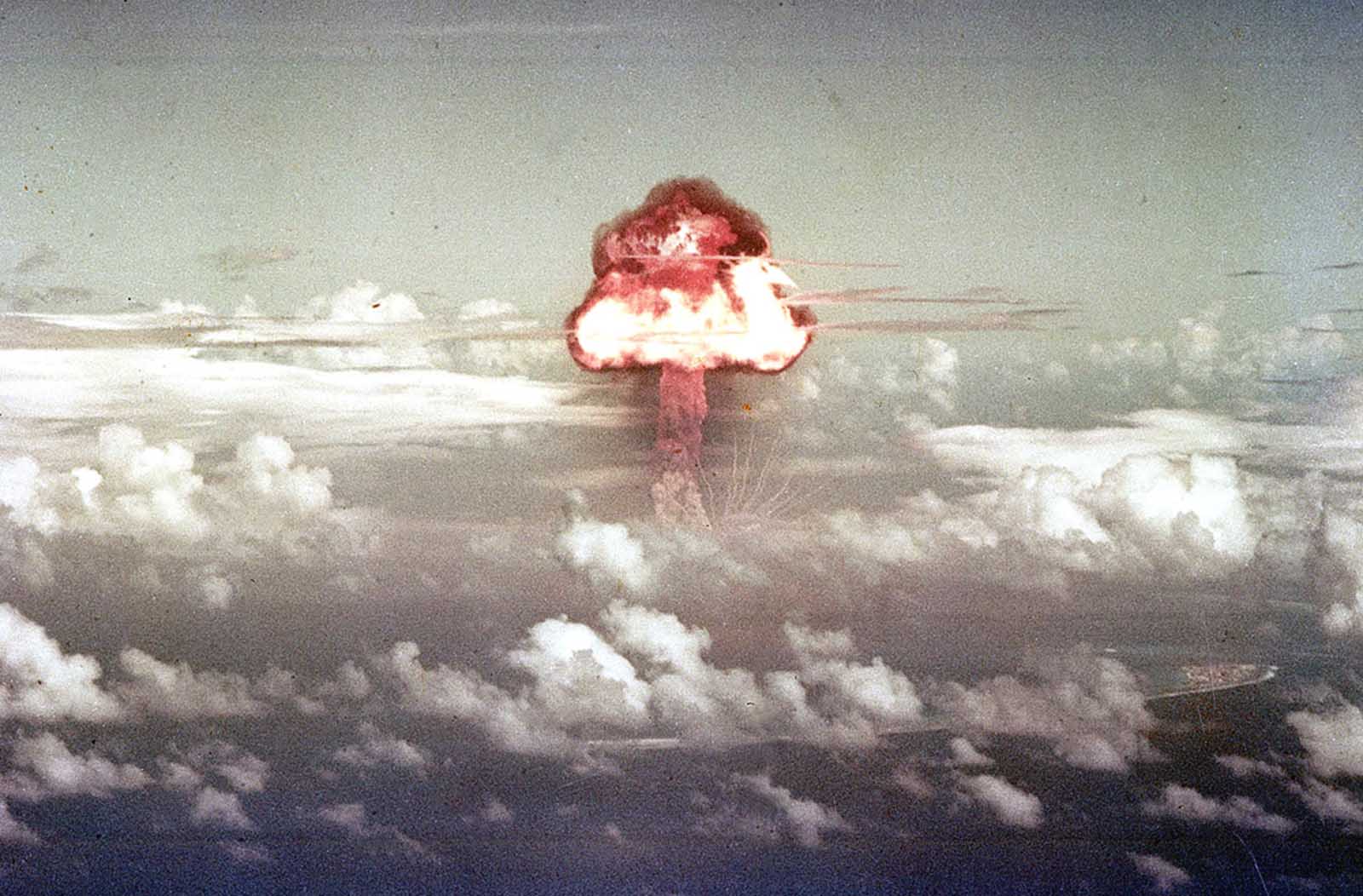
On November 16, 1952, a B-36H bomber dropped a nuclear bomb over a point north of Runit Island in the Enewetak atoll, resulting in a 500-kiloton explosion, as part of a test code-named Ivy.
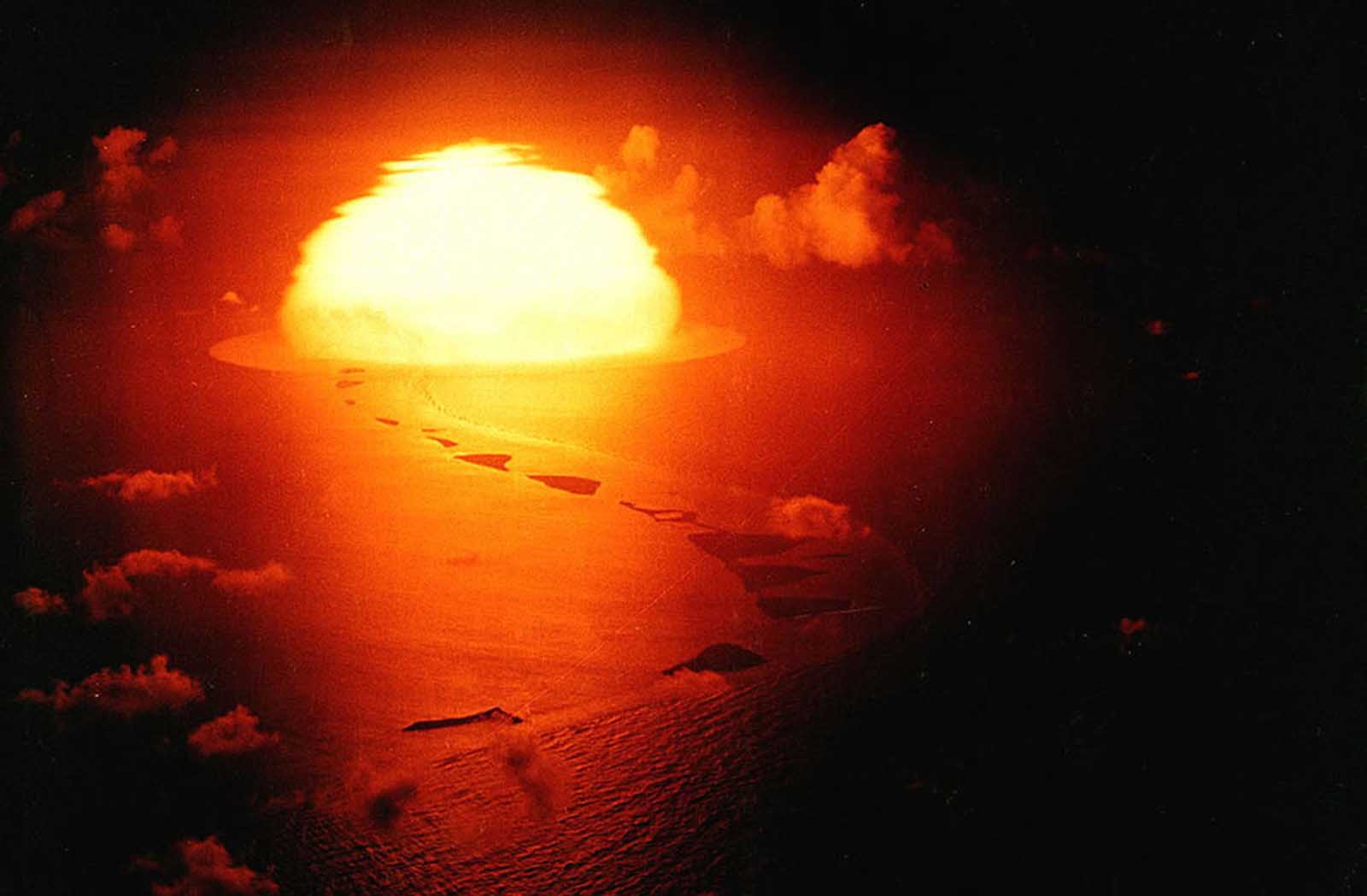
Operation Greenhouse took place in the spring of 1951, consisting of four explosions at the Pacific Proving Grounds in the Pacific Ocean. This photo is from the third test, George, on May 9, 1951: the first thermonuclear bomb test, yielding 225 kilotons.

“Rope tricks” are seen in this image of a nuclear explosion taken less than one millisecond after detonation. During Operation Tumbler-Snapper in 1952, this nuclear test device was suspended 300 feet above the Nevada desert floor and anchored by mooring cables. As the ball of plasma expanded, the radiating energy superheated and vaporized the cables just ahead of the fireball, resulting in the “spike” effects.

Mannequins that represent a typical American family will soon experience the fury of an atomic blast with the power of 40,000 tons of TNT at Yucca Flat, Nevada, on April, 24, 1955. The test is being conducted to determine the survival chances of an atomic attack. Visible through the window is the tower 4,700 feet away on which the detonation will occur.

(1 of 2) In Operation Doorstep, conducted during the larger Operation Upshot-Knothole nuclear bomb test, mannequins are seated at a table in the dining room of House No. 2, attending a “dinner party” thrown by Civil Defense officials who are testing the effects of an atomic explosion on houses and occupants on March 15, 1953.
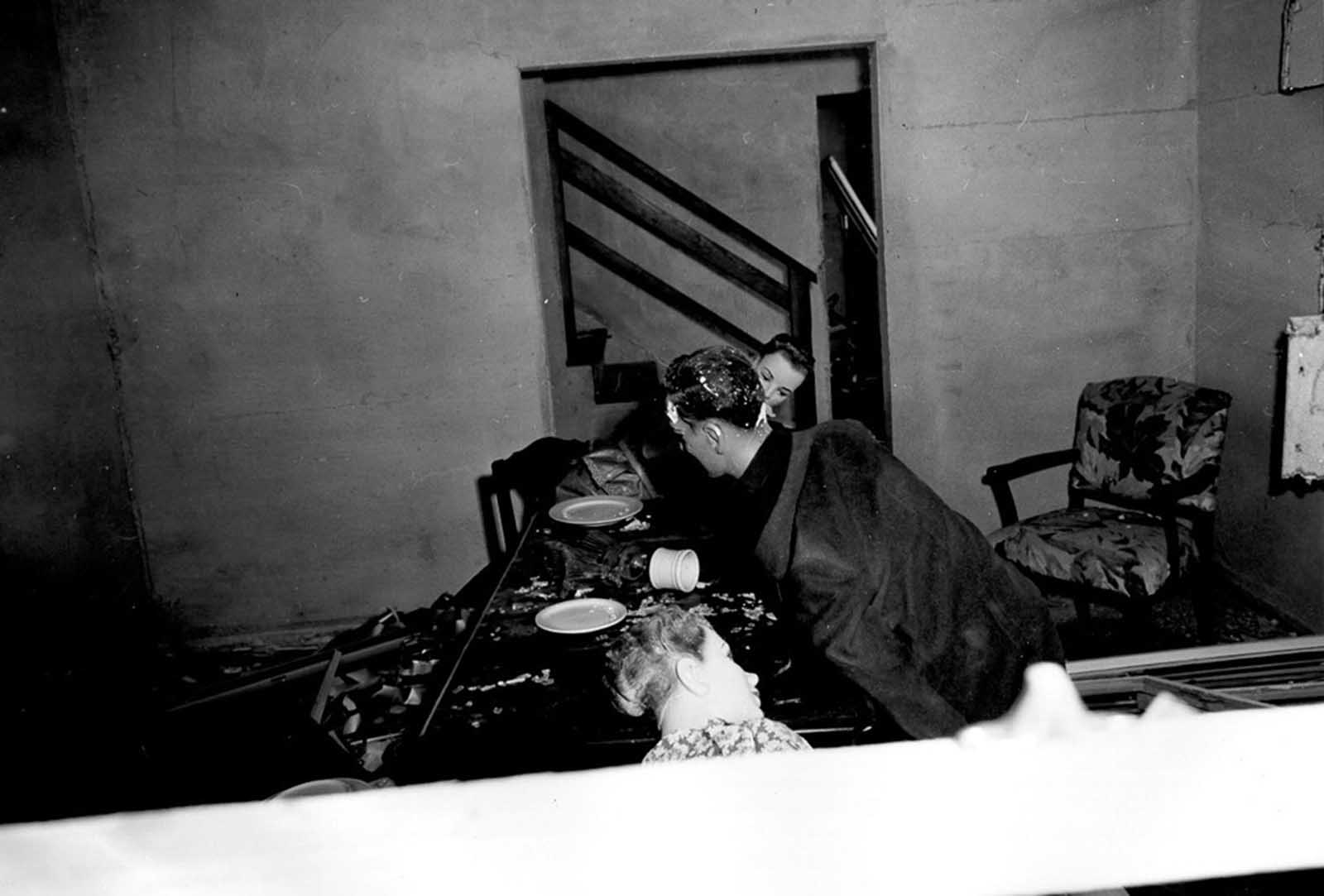
(2 of 2) After the blast, mannequins lie strewn about the room, their “dinner party” interrupted violently by an atomic blast on March 17, 1953.

(1 of 2) Stretched on a bed, in an upstairs bedroom of House No. 2, is a mannequin ready to test the effects of an atomic explosion at the atomic proving grounds near Las Vegas, Nevada, March 15, 1953. Through the window, a mile and a half away stands a 300-foot steel tower atop which the bomb will be detonated. The purpose of the test blast is to show Civil Defense officials what would happen in an American city if it were subjected to an atomic attack.

(2 of 2) After the blast, a damaged bedroom, window, and blankets missing, resulting from a test during an atomic blast on March 17, 1953.

(1 of 2) Mannequins representing a typical American family gathered in a living room are pictured on March 15, 1953, in House No. 2, awaiting an atomic test explosion on the Nevada Proving Grounds.
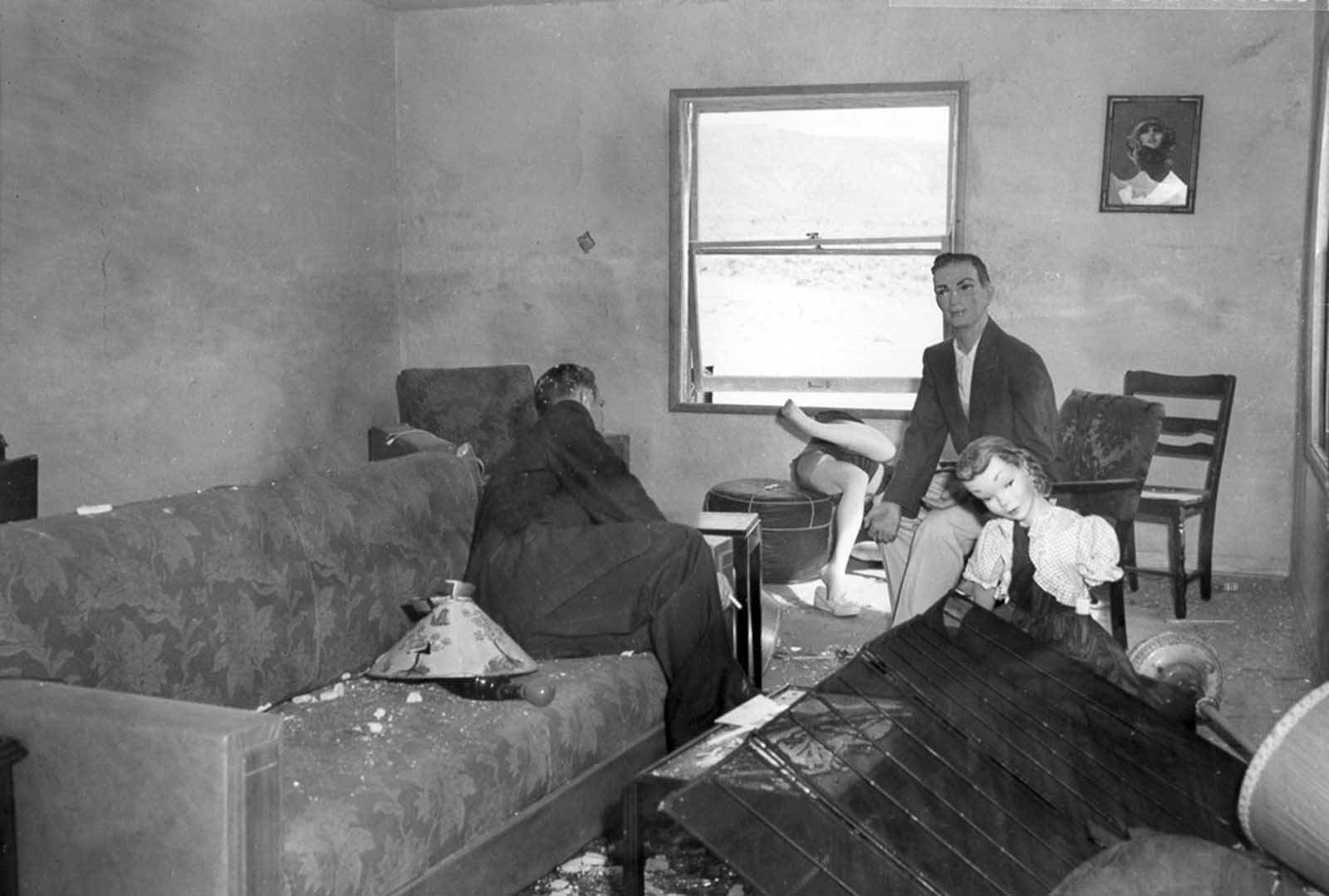
(2 of 2) After the blast, a damaged living room, members of the mannequin family tossed about or missing after an atomic blast on March 17, 1953.

During the Plumbbob test at the Nevada Test Site on August 30, 1957, the Franklin Prime shot is detonated from a balloon in Yucca Flat at an altitude of 750 feet.

The test explosion of a hydrogen bomb during Operation Redwing over the Bikini Atoll on May 20, 1956.

Ionization glow surrounds the cooling fireball of the Diablo shot, fired in Yucca Flat at 4:30 a.m. on Monday, July 15, 1957.
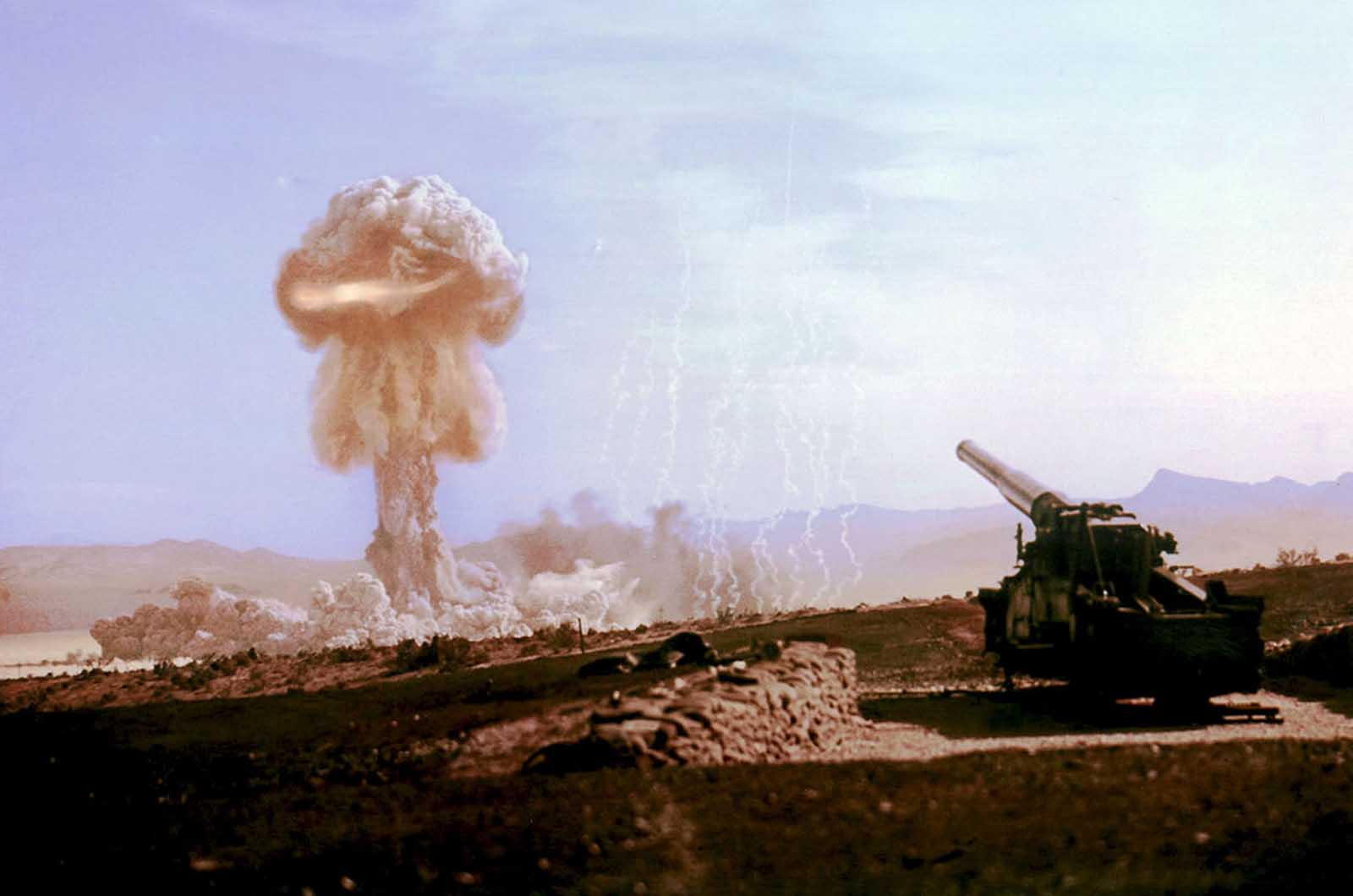
Operation Upshot-Knothole Grable, a test carried out by the U.S. military in Nevada on May 25, 1953. A 280mm nuclear shell was fired 6 miles into the desert by the M65 Atomic Cannon, detonating in the air, about 500 feet above the ground, with a resulting 15-kiloton explosion.
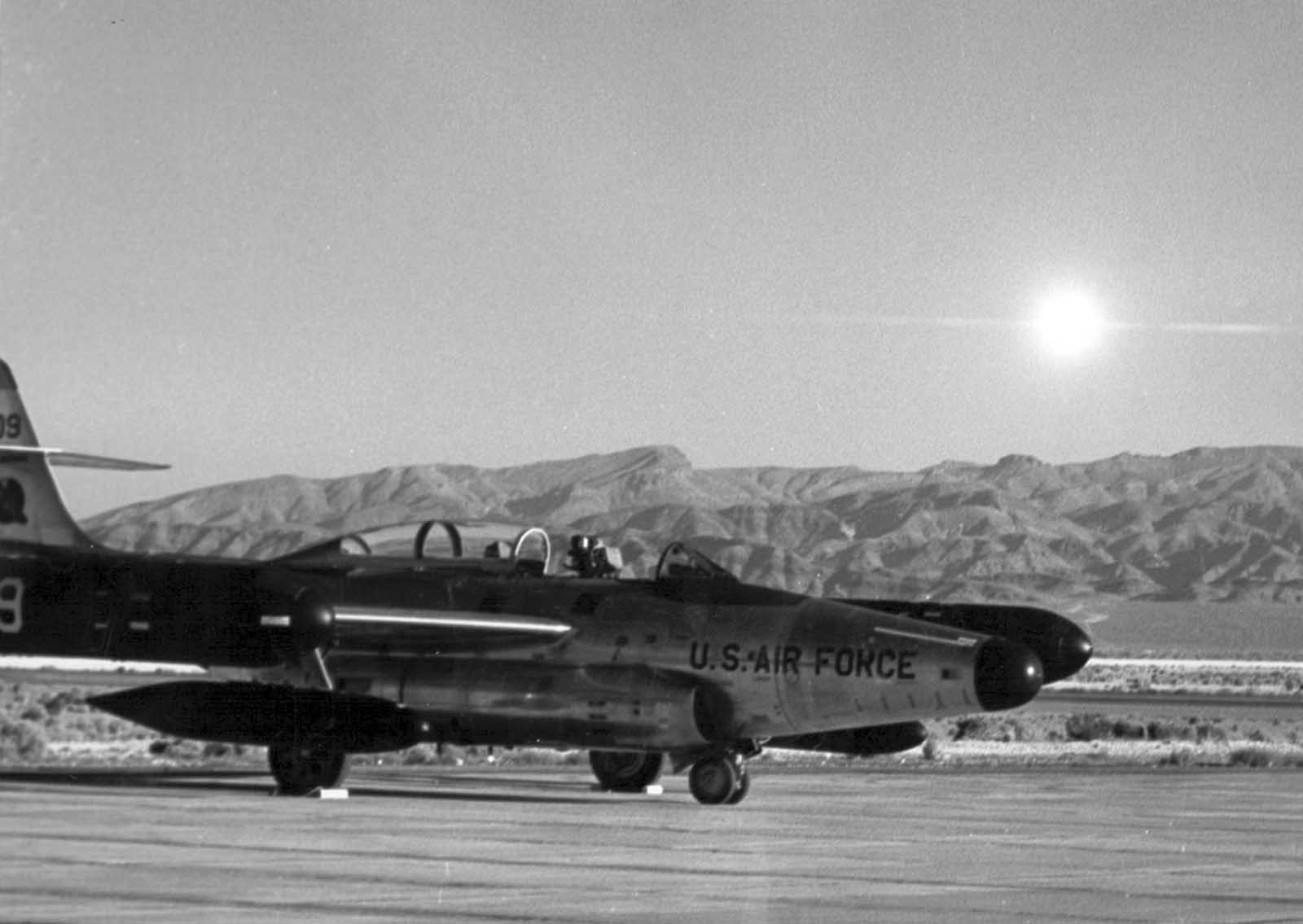
The flash of the exploding nuclear warhead of an air-to-air rocket is shown as a bright sun in the eastern sky at 7:30 a.m. on July 19, 1957 at Indian Springs Air Force Base, some 30 miles away from the point of detonation. A Scorpion, sister ship of the launching aircraft, is in the foreground.
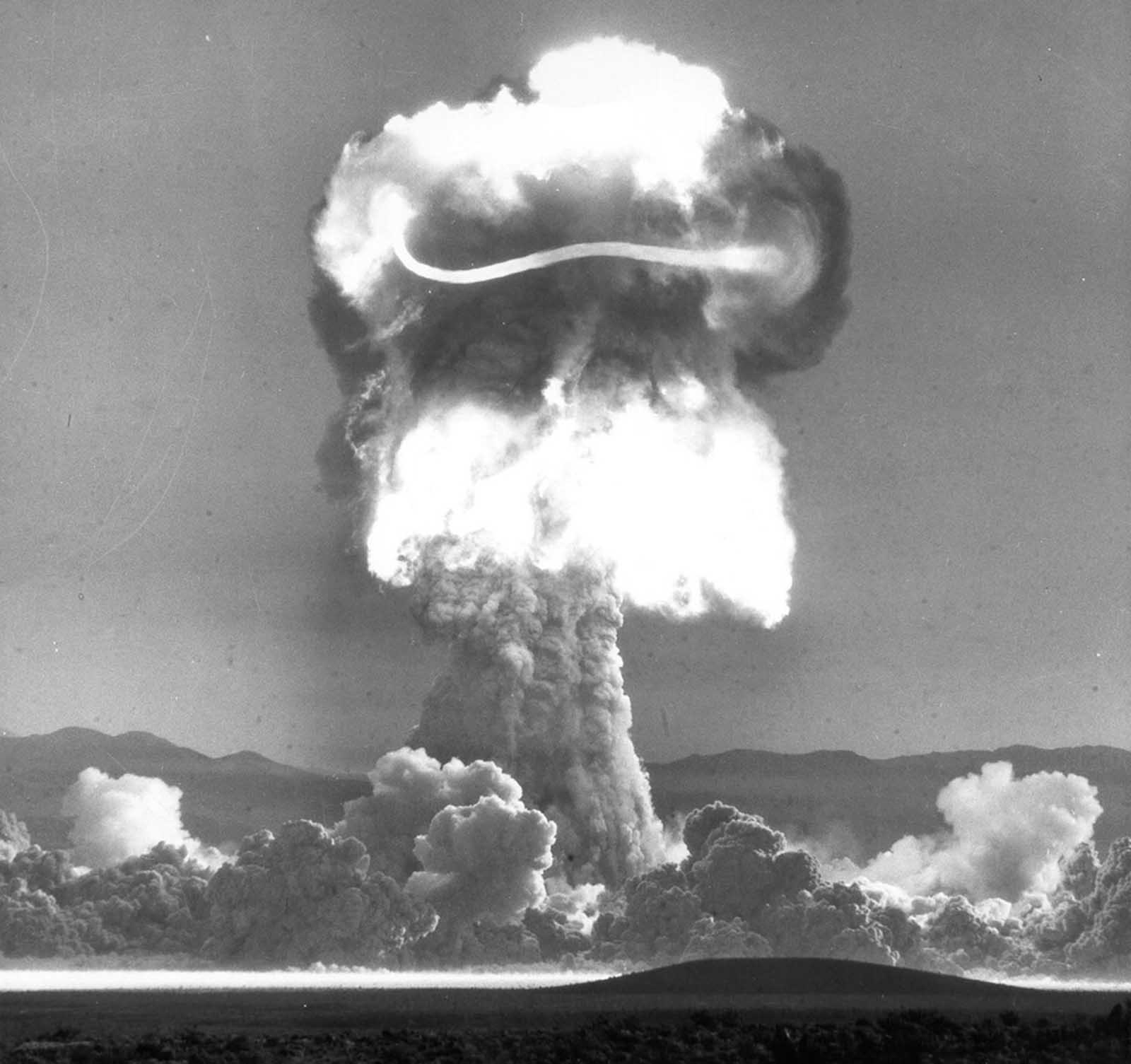
The fireball of the Priscilla shot, fired on June 24, 1957, as a part of the Operation Plumbbob series.

NATO observers watch the detonation of Operation Plumbbob Boltzmann on May 28, 1957.

The tail section of a U.S. Navy blimp is shown with the Stokes cloud in the background at the Nevada Test Site on August 7, 1957. The blimp was in temporary free flight in excess of five miles from ground zero when it was collapsed by the shock wave from the blast. The airship was unmanned and was used in a military effects experiment.

Observers view atmospheric testing during Operation Hardtack I, a thermonuclear detonation during the Pacific tests in 1958.

A view of the Arkansas test, part of Operation Dominic, a series of over 100 nuclear test explosions in Nevada and the Pacific in 1962.

The rising fireball of the Aztec test, part of Operation Dominic, a series of over 100 nuclear test explosions in Nevada and the Pacific in 1962.

Shot during Operation Fishbowl Bluegill, this is an image of an explosion of a 400-kiloton nuclear bomb taking place in the atmosphere, 30 miles above the Pacific, as viewed from above in October 1962.

Expanding rings surround a mushroom cloud during the Yeso test explosion, part of Operation Dominic, a series of over 100 nuclear test explosions in Nevada and the Pacific in 1962.

Sedan Crater was formed when a 100-kiloton explosive buried under 635 feet of desert alluvium was fired at the Nevada Test Site on July 6, 1962, displacing 12 million tons of earth. The crater is 320 feet deep and 1,280 feet in diameter.
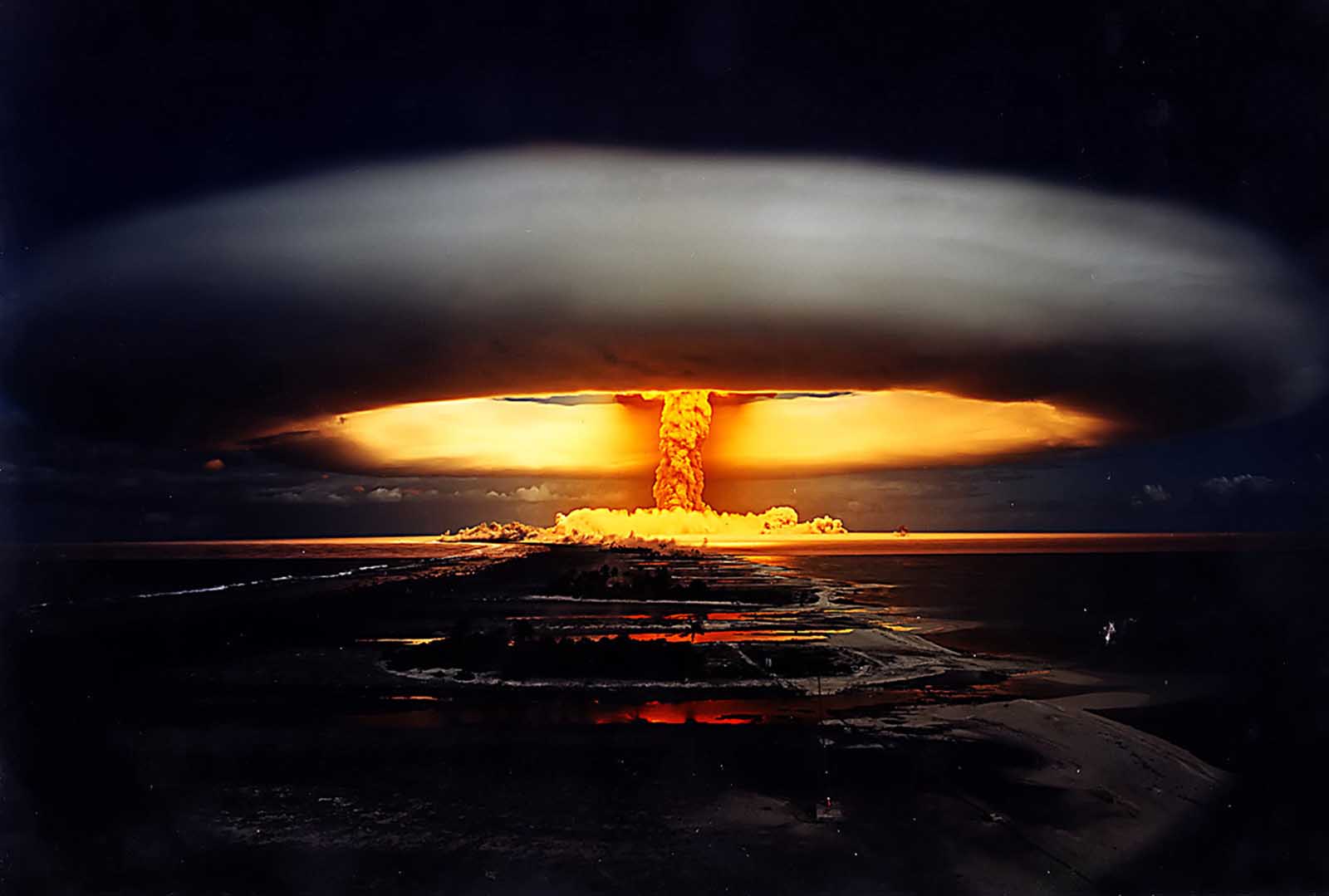
A 1971 photo of a nuclear bomb detonated by the French government at the Moruroa atoll, French Polynesia.

A photo of a nuclear bomb detonated by the French government at the Moruroa atoll, French Polynesia.
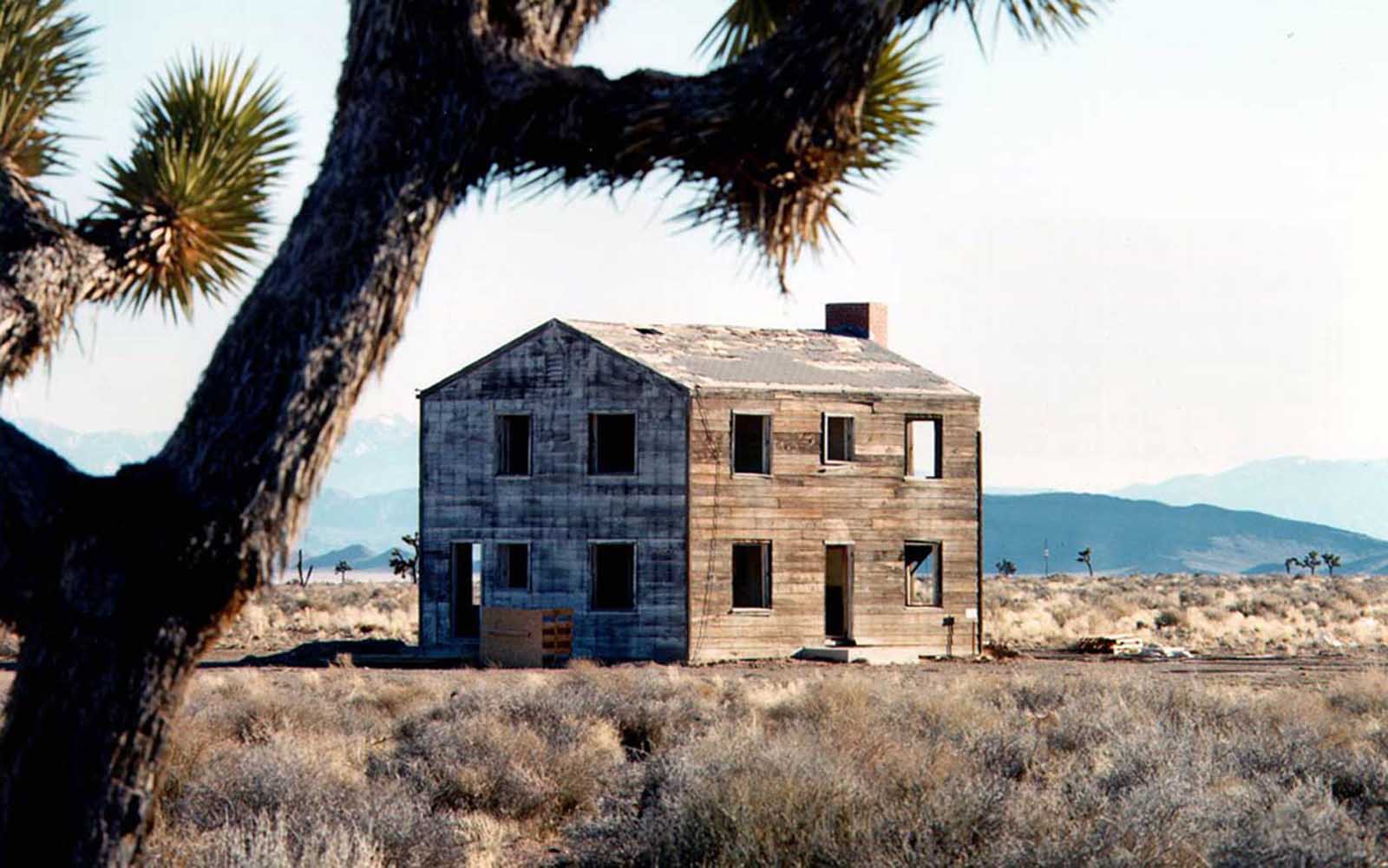
This “Survival Town” house, photographed recently, was built some 7,500 feet from a 29-kiloton nuclear detonation—it remained essentially intact. Survival Town consisted of houses, office buildings, fallout shelters, power systems, communications equipment, a radio broadcasting station, and trailer homes. The test, called Apple II, was fired on May 5, 1955.
(Photo credit: AP / U.S. Department of Defense / Text from F. G. Gosling, The Manhattan Project: Making the Atomic Bomb).